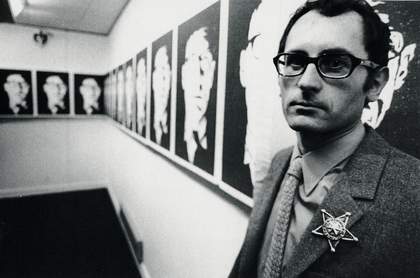Born 1931 in Paris, France, where he lives and works.

Bernard Rancillac at the opening of The Americans at Gallery Mommaton, Paris, in 1968
Courtesy the artist
© ADAGP, Paris and DACS, London 2015
Photo: André Morin
As the co-organiser of the seminal exhibition Mythologies Quotidiennes in 1964 in Paris, considered to be the founding point of figuration narrative, Bernard Rancillac was at a very early stage engaged with a critical re-appropriation of pop art’s figurative language. Abandoning informal and abstract painting in 1962, he became a pioneer of French figuration narrative, working from photographic images in magazines, advertisements, popular imagery and comic strips and reinterpreting them to highlight their political implications. Increasingly preoccupied by the socio-political context in which he was painting, in 1966 Rancillac decided to illustrate all key events of that year. Developing the process of juxtaposition of images taken from the press, Rancillac offered critical commentaries on topical issues, notably the Vietnam War, decolonisation, military dictatorships, poverty in developing countries and socio-cultural changes in Western societies. He participated in the production of posters at the Atelier Populaire in May 1968 and pursued his political paintings throughout the 1970s.
In May 1966, social and celebrity magazine Paris Match published a photograph of an African art collector’s dinner, showing the wealthily dressed guests sat around the dinner table, in a lavish Parisian interior, posing with African masks covering their faces. This was concurrent with the opening of the World Festival of Black Arts, organised in Dakar by the Republic of Senegal’s President, Leopold Sedar Senghor – a major international event for the recognition of African arts in Western countries, where they were becoming luxury items in the 1960s. Re-appropriating this photograph and its title in The Dinner of the Heads Collectors 1966, Bernard Rancillac critiqued this bourgeois scene by incorporating three moveable sections with the portraits of Frantz Fanon, Patrice Lumumba and Malcom X, iconic activists in the anti-colonial independence struggles in Algeria, Congo and the USA, all of whom had died in the early 1960s. A direct reference to Fanon’s book Black Skin, White Masks (1952), this painting addressed issues around (de)colonisation. Revealing what is hidden behind mass-consumer society lies at the heart of At Last, A Silhouette Slimmed to the Waist 1966, which juxtaposes two images top to tail and can be hung either way, in order to emphasise either the advertisement for female underwear or the horrors of the Vietnam War. Other societal issues were addressed by Rancillac in 1966, such as the controversial debate around the legalisation of the contraceptive pill and the conquest of new territories within the private and public realms by women in Pilules Capsules Conciliabules.
Elsa Coustou
September 2015
